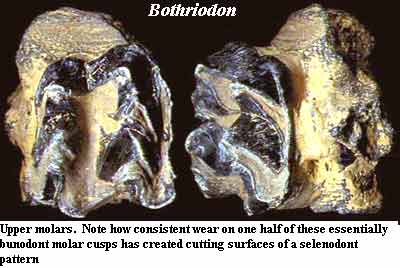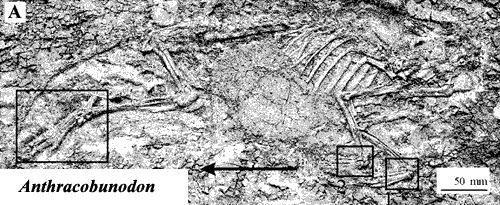 Anthracotheroidea
Anthracotheroidea| Cetartiodactyla | ||
| The Vertebrates | Derived Suina |
| Vertebrates Home | Vertebrate | Vertebrate |
|
Abbreviated Dendrogram
Laurasiatheria
├─Ferae
└─┬─Perissodactyla
│
└─Cetartiodactyla
├─Cetacea
│ ├─Pakicetidae
│ └─Autoceta
└─Artiodactyla
└─┬─Suina
│ ├─Hippopotamidae
│ └─┬─Anthracotheroidea
│ └─┬─Entelodontoidea
│ └─Suoidea
└─Selenodontia
├─Camelidae
└─Ruminantia
├─Giraffoidea
└─┬─Bovoidea
└─Cervoidea
|
Contents
Overview |
 Anthracotheroidea
AnthracotheroideaThe Anthracotheroidea were created by combining a number of similar families long recognized in mammal paleontology. At least as used here (i.e., blindly following Mikko Haaramo without actually reading the literature or giving the matter any serious thought), Anthracotheroidea is a moderately large group encompassing forms traditionally placed within (or near) the dichobunids, including the Haplobunidae, Choeropotamidae, and Anthracotheriidae. Other taxonomists [SL00] see these animals as isolated twigs of the stem group artiodactyls (that is, basal to the suine - selenodont split).
Older phylogenies placed them within the Selenodontia because their more derived taxa had selenodont teeth. That is, the molar cusps form regular arcs. However, this effect is easily achieved simply by wearing away at one side of standard-issue bunodont cusps, as shown in the image of Bothriodon's molars here.
In many, perhaps most, phylogenies, this taxon includes the Hippopotamidae. Early anthracotheroids were small. See the image of Anthracobunodon below. Later anthracotheroids were indisputably large and generally hippo-like in aquatic habit and adaptations [PS02]. Traditionally, the story was also told that the decline of the anthracotheres was closely correlated with the rise of the hippos,  who, in turn were marginalized by bovids of various sorts [C88]. However, in critical details, the last anthracotheres were not very similar to the first hippos, and the timing no longer seems suggestive. Indeed, the entire clade disappeared too soon to have produced the first known hippo, Kenyapotamus [PS02] [????]. ATW040724.
who, in turn were marginalized by bovids of various sorts [C88]. However, in critical details, the last anthracotheres were not very similar to the first hippos, and the timing no longer seems suggestive. Indeed, the entire clade disappeared too soon to have produced the first known hippo, Kenyapotamus [PS02] [????]. ATW040724.
Images: Bothriodon molars from Allen Morton's site: A Collection of Eocene and Oligocene Fossils.
We are fortunate in having the BBC do their recent best to bring some entelodontoids back to virtual life Walking with Beasts.. The focus on the last and largest of the group, the Early Miocene Daeodon, is understandable and only slightly misleading. The entelodontoids apparently evolved in China, where they are represented by the Middle Eocene Eoentelodon. However, their greatest success was in the Late Eocene and Oligocene of North America. They spread to Europe in the Early Oligocene and also had considerable success there [PS02].
Unlike the oreodonts, the entelodontoids are clearly monophyletic. They share a number of distinctive features, including premolars with little molarization, and a characteristic wear pattern in which the tips of the non-molars are all worn flat. The implication is that they used these teeth for tearing and even crushing [PS02], although there is less agreement as to who or what, exactly, was being torn and/or crushed. Interestingly, at least some North American oreodonts show the same pattern. See, for example [MM03]. The entelodonts, however, also possessed unusually good lateral jaw mobility.
Another characteristic of the entelodontoids is the tendency to develop bony outgrowths of the zygomatic arch, dentary and the widely-flaring jugal [C88]. This is a pattern we have seen elsewhere in pareiasaurs, ankylosaurs and several therapsid lines. It probably relates to intraspecific combat, since serious (not merely ritual) seasonal combat among males is an almost constant feature of the artiodactyls. ATW040724.
 Anthracotheroidea:
Amphirhagatherium, Bothriodon, Choeropotamus,and Hyoboops.
Anthracotheroidea:
Amphirhagatherium, Bothriodon, Choeropotamus,and Hyoboops.
Range: strongly dependent on what is included. Certainly Middle and Late Eocene of Europe, China and Southeast Asia. May extend to Early Eocene in Southeast Asia. Cosmopolitan in Oligocene and Early Miocene. Extinct by mid-Pleistocene.
Phylogeny: Suina ::: (Entelodontoidea + Suoidea) + *.
Characters: later genera very large and hippo-like (Merycopotamus) [C88]; primitively more bulbous teeth than dichobunids [C88]; molars with strong, continuous cingulum [C88]; derived genera with selenodont teeth (see image) [C88]; limbs short, stout & without cursorial adaptations [C88]; metapodials unfused [C88]; digits 5/4 [C88].
Image: Anthracobunodon from Erfurt's fourth Page slightly modified to improve contrast). Note the extremely small size of this specimen. Life reconstruction of Bothriodon adapted from [PS02].
Links: Anthracotheroidea Mikko's Phylogeny); Chapter 1- Action Plan; Erfurt's fourth Page.
References: Carroll (1988) [C88], Prothero & Schoch (2002) [PS02], Sudre & Lecomte (2000) [SL00]. ATW040721.
 Entelodontoidea: Daeodon, Eoentelodon.
Entelodontoidea: Daeodon, Eoentelodon.
Range: Middle Eocene [PS02] to Early Miocene of China, North America & Europe [C88]
Phylogeny: Suina :::: Suoidea + *.
Characters: some very large; bony lateral processes from zygomatic arch and lower jaw [C88]; males with exaggerated canines [PS02];.
Links: Entelodontoidea Mikko's Phylogeny); Entelodonte; ABC - Walking with Beasts - Entelodont General Evidence; NCRV - Entelodont; ★별과 화석♣ - 엠파스 블로그 Best on the Web); 東海大自然史:展示:2階;
References: Carroll (1988) [C88], MacFadden & Morgan 2003) [MM03], Prothero & Schoch (2002) [PS02]. ATW040724.
checked ATW040705